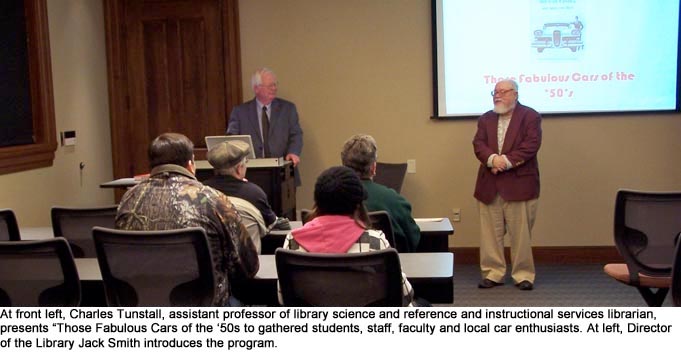 They just don’t make them like that anymore. The “Fabulous Cars of the ’50s” was the topic of a lecture presentation held Tuesday, January 26, at the Thomas J. Garland Library on the Tusculum College campus.
They just don’t make them like that anymore. The “Fabulous Cars of the ’50s” was the topic of a lecture presentation held Tuesday, January 26, at the Thomas J. Garland Library on the Tusculum College campus.
More than 15 people braved the snowy weather and were treated to a lively presentation by Charles Tunstall, assistant professor of library science and reference and instructional services librarian. Tunstall, a self-proclaimed car enthusiast, presented a wide selection of cars through the decade along with information and trivia about their makers and in some cases those who owned them.
Many of the cars presented during the presentation were those of the “Big Three” automotive manufacturers of the time – Ford, General Motors and Chrysler; however, Tunstall also offered some more rare models including those from Studebaker, Willys, Kaiser, Fraser and Nash.
Most of the cars of the 1950s were larger models, according to Tunstall, as Americans were seeing low gas prices and the automobile was the ultimate status symbol. One interesting tidbit about the early years, Kaiser actually sold their “Henry J” and other models out of the appliance section of the Sears and Roebuck store.
Some of the key trends through the decade of the 1950s included moving away from dual panel windshields to the single panel we see on cars today, as well as the rise in popularity of fins and an increased number of models made with quad headlights.
No discussion of the 1950s cars would be complete without the discussion of the Ford Edsel, which has been described as the “worst financial disaster in the automotive industry.” Tunstall described the development of the Edsel as being developed based on market research conducted by Ford.
Unfortunately for the Detroit manufacturer, despite giving the public what they said they wanted, the Edsel took so long to get to production that “by the time it came out, the public had changed its mind,” Tunstall told the group.
Also making its private consumer debut was the Jeep, initially a GP, general purpose, vehicle used in World War II. According to Tunstall, the Jeep was produced for the public market after many veterans returned with a fondness for the vehicle from their time in service.
The photo slide show driven presentation ended up with the cars of 1960, as manufacturers finally began producing a few compact cars as the American public turned their attention to imports, such as the popular Volkswagen.


